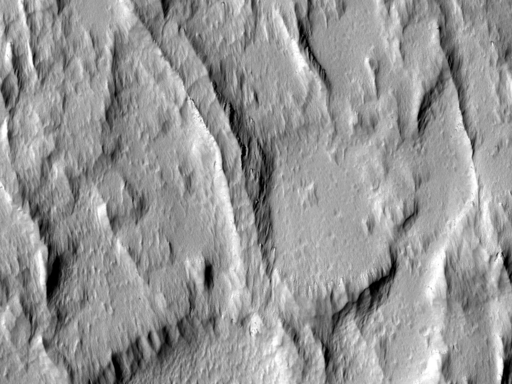HiRISE Sample of Dust-Covered Olympus Mons Lava Flows
 Highlighted Portion of HiRISE Image TRA_000838_1945
Highlighted Portion of HiRISE Image TRA_000838_1945This picture shows a small part of a HiRISE image taken over the southern flanks of the largest volcano in the Solar System, Olympus Mons. Olympus Mons towers more than 20 kilometers (65 thousand feet) above the surrounding plains. While scientists still are not certain when it last erupted, Olympus Mons is one of the youngest volcanoes on Mars. However, as this picture shows, its lava flows are covered by a thick deposit of wind blown dust. This mantle largely buries the lava, but some underlying features can still be discerned. The pair of parallel ridges running through the middle of the picture are the margins of a buried lava channel. This channel originally formed as a flow of molten lava that had its sides freeze as it advanced. When the eruption ended, the lava continued to flow out of the middle of the flow, leaving an empty channel with high walls. Dust has now filled the channel, but the tops of the channel margins poke through in a few places, as shown by the rocks rolling down onto the dust. The curving cliff at the bottom of the image is the margin of a dust covered impact crater. While the high resolution that the HiRISE camera delivers provides little new information on the lava flows, it does allow a better understanding of the nature of the dust cover and how it is being moved and sculpted by wind.
Image TRA_000838_1945 was taken by the High Resolution Imaging Science Experiment (HiRISE) camera onboard the Mars Reconnaissance Orbiter spacecraft on September 30, 2006. The complete image is centered at 14.2 degrees latitude, 227.6 degrees East longitude. The range to the target site was 270.6 km (169.1 miles). At this distance the image scale ranges from 54.1 cm/pixel (with 2 x 2 binning) to 108.3 cm/pixel (with 4 x 4 binning). The image shown here [below] has been map-projected to 50 cm/pixel and north is up. The image was taken at a local Mars time of 3:25 PM and the scene is illuminated from the west with a solar incidence angle of 49 degrees, thus the sun was about 41 degrees above the horizon. At a solar longitude of 114.1 degrees, the season on Mars is Northern Summer.
 HiRISE Image TRA_000838_1945
HiRISE Image TRA_000838_1945
Images from the High Resolution Imaging Science Experiment and additional information about the Mars Reconnaissance Orbiter are available online at:
http://hirise.lpl.arizona.edu/
or
For information about NASA and agency programs on the Web, visit: http://www.nasa.gov. NASA's Jet Propulsion Laboratory, a division of the California Institute of Technology in Pasadena, manages the Mars Reconnaissance Orbiter for NASA's Science Mission Directorate, Washington. Lockheed Martin Space Systems is the prime contractor for the project and built the spacecraft. The HiRISE camera was built by Ball Aerospace and Technology Corporation and is operated by the University of Arizona.
